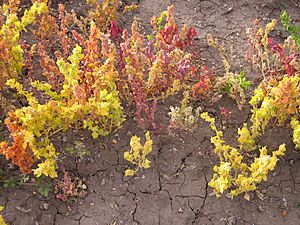Chenopodium pallidicaule facts for kids
Quick facts for kids Chenopodium pallidicaule |
|
|---|---|
 |
|
| Chenopodium pallidicaule growing in Atuncolla near Sillustani, Peru, at an elevation of ca. 3,900 metres | |
| Scientific classification | |
| Genus: |
Chenopodium
|
| Species: |
pallidicaule
|
Cañihua (say "can-yee-wah") is a special plant that grows in the Andes mountains. Its scientific name is Chenopodium pallidicaule. People also call it canihua or cañahua. It's very similar to quinoa, another well-known plant from the Andes.
Cañihua has been grown in the high plains (called the Altiplano) for thousands of years. It's a super tough plant that can handle the cold mountain weather. It's also packed with good stuff like protein and dietary fiber, which are important for your body.
Contents
What Does Cañihua Look Like?
Cañihua is a small plant that grows every year. It's usually about 20 to 60 centimeters tall, which is shorter than quinoa.
There are two main types of cañihua:
- The lasta type has many branches.
- The saguia type has fewer branches and grows straighter.
Its flowers are tiny and don't have petals. The plant makes small, dark fruits that hold tiny brown or black seeds. These seeds are very small, about the size of a poppy seed. When the plant is ready to be harvested, its stems and leaves change color to yellow, red, green, or purple.
How Do People Use Cañihua?
Cañihua is very useful! People can easily grind its seeds into flour. This flour can then be toasted to make something called cañihuaco.
Cañihuaco: A Nutty Treat
Cañihuaco has a yummy nutty taste. People often mix it with water or milk for breakfast. It's full of energy and protein, so people in the Andes sometimes take it with them on long trips.
More Ways to Use Cañihua Flour
Cañihua flour can be used for many other things too:
Some types of cañihua can even be used in sweets, snacks, and special food for babies.
Helping People Get Enough Food
Cañihua is very important for food security in the Andes. This means it helps make sure people have enough food to eat, especially in areas where it's hard to grow other crops. It's easy to get and can survive dry weather, which makes it a great source of food and income for farmers in the mountains.
New ways of processing cañihua are being developed. This helps companies use more of these native Andean crops. It also helps more people eat cañihua and creates new markets for farmers.
What Makes Cañihua So Healthy?
Cañihua, along with quinoa and kiwicha (another Andean crop), is super healthy! They have a lot of protein and dietary fiber. They also have more calcium, zinc, and iron than many common grains like wheat or oats.
Cañihua seeds have about 15.3% protein, which is more than quinoa. It also has healthy fats. Unlike quinoa, cañihua has less of a bitter substance called saponins, which means it tastes better without needing much preparation.
Growing Cañihua
Cañihua is a plant that grows wild in some places but is also grown by farmers for its seeds. Both the seeds and the leaves can be eaten.
In the past, cañihua was grown a lot in South America. In Bolivia, there are over 200 different types of cañihua, but only about 20 are still grown today.
Where Cañihua Likes to Grow
Cañihua is very good at growing in the Andes climate. It can handle cold weather at all stages of its growth. Adult plants can even survive freezing nights. It can grow in temperatures up to 28°C if there's enough moisture.
Cañihua can grow at very high altitudes, from 1,500 meters up to 4,400 meters above sea level. It's usually grown above 3,800 meters. This plant is tough! It can resist strong winds, heavy rain, most pests and diseases, and even long dry periods. It doesn't need extra watering if it gets 500 to 800 millimeters of rain during its growing season.
It doesn't like shade or too much humidity. Cañihua can grow in almost any kind of soil, even shallow, acidic, or salty soils.
How Cañihua Grows
Cañihua is an annual crop, meaning it grows and produces seeds within one year. It takes about 95 to 150 days to be ready for harvest, depending on the type. Seeds start to sprout when the soil temperature is around 5°C. It flowers from July to October when temperatures are about 10°C, and its seeds ripen from August to October at about 15°C.
Harvesting Cañihua
Farmers need to harvest cañihua when its color changes, but before it's fully ripe. This stops the seeds from falling out and being lost. The plants are cut, dried, and then the seeds are removed by hand or with a machine.
The seeds have papery husks that need to be washed and rubbed off. Farmers usually get about 400 to 900 kilograms of seeds from one hectare of land. In more modern farming, they can get 2 to 3 tons. Cañihua seeds are very light; 1,000 seeds weigh only about 480 milligrams. For comparison, 1,000 quinoa seeds weigh much more, about 1,900 to 4,000 milligrams.
The Future of Cañihua
Cañihua was once very popular in the Andes but was later replaced by other crops like millet. Today, it's mostly grown in very high places where quinoa or millet can't grow.
Just like quinoa became popular around the world, cañihua also has a growing chance to become more well-known. It has even been grown in Finland with good results! It's also a low-risk crop because it mostly pollinates itself, meaning it's unlikely to mix with other plants. Scientists are working to make cañihua even better by trying to reduce seed scattering and make the seeds bigger.
See also
 In Spanish: Cañahua para niños
In Spanish: Cañahua para niños

